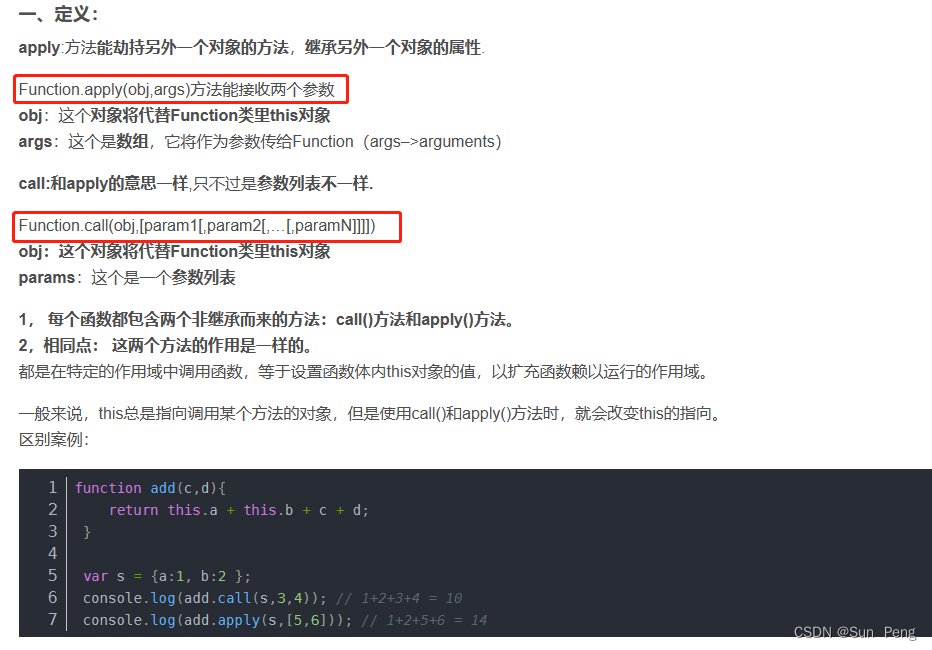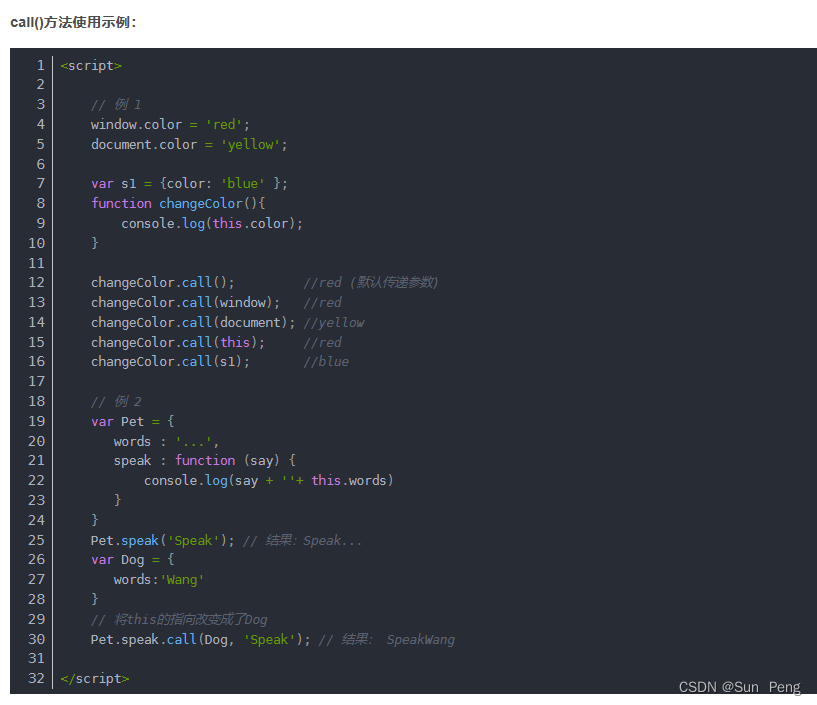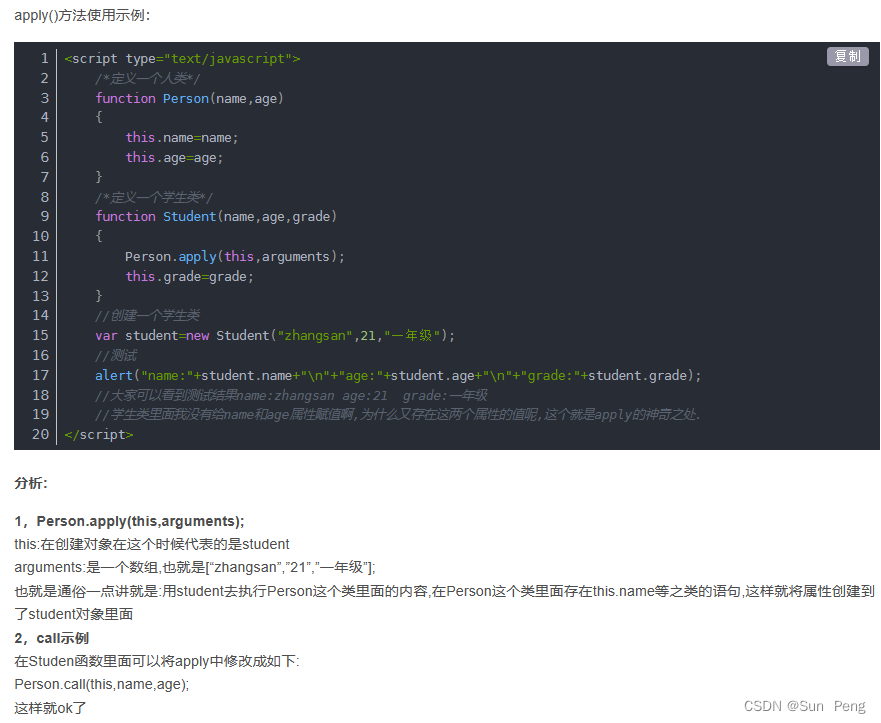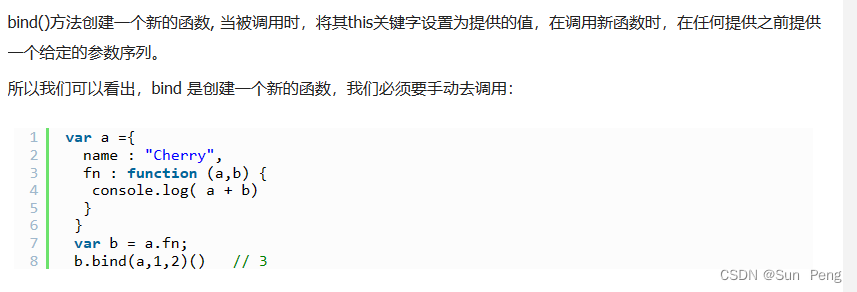一、区别:
call、apply、bind相同点:都是改变this的指向,传入的第一个参数都是绑定this的指向,在非严格模式中,如果第一个参数是nul或者undefined,会把全局对象(浏览器是window)作为this的值,要注意的是,在严格模式中,null 就是 null,undefined 就是 undefined
call和apply唯一的区别是:call传入的是参数列表,apply传入的是数组,也可以是类数组
bind和call、apply的区别: bind返回的是一个改变了this指向的函数,便于稍后调用,不像call和apply会立即调用;bind和call很像,传入的也是参数列表,但是可以多次传入,不需要像call,一次传入
值得注意:当 bind 返回的函数 使用new作为构造函数时,绑定的 this 值会失效,this指向实例对象,但传入的参数依然生效 (new调用的优先级 > bind调用)

二、案例:



三、实现:
【1】call实现
对象context想调用一个它没有的方法f 怎么办呢?f.call(context) 通过call来借用方法f ,怎么做到的呢
- 对象context添加f方法
- 对象context执行f方法
Function.prototype.myCall = function(context, ...arg) {
// 如果第一个参数传入的是undefined和null,context为window对象
context = context || window;
// 为context对象添加函数bar
context.fn = this; // this:bar,this指向调用myCall的bar
// context对象执行函数bar,并返回结果
return context.fn(...arg);
}
// 测试一下
var value = 2;
var obj = {
value: 1
}
function bar(name, age) {
console.log(this.value);
return {
value: this.value,
name: name,
age: age
}
}
bar.myCall(null); // 2 this指向window
console.log(bar.myCall(obj, 'kevin', 18)); //1 this指向obj Object {
value: 1,name: 'kevin',age: 18}
【2】apply实现
apply和call唯一的区别是:call传入的是参数列表,apply传入的是数组,也可以是类数组
Function.prototype.myApply = function(context, arg) {
// 如果第一个参数传入的是undefined和null,context为window对象
context = context || window;
// context对象添加函数bar
context.fn = this; // this:bar,this指向调用myCall的函数bar
// context对象执行函数bar,并返回结果
let result = null;
if (!arg) {
// 没有传入数组
result = context.fn();
}else{
// 传入了参数数组
result = context.fn(...arg);
}
return result;
}
// 测试一下
var value = 2;
var obj = {
value: 1
}
function bar(name, age) {
console.log(this.value);
return {
value: this.value,
name: name,
age: age
}
}
bar.myApply(null); // 2
console.log(bar.myApply(obj, ['kevin', 18])); // 1 传入的是数组['kevin', 18]
【3】bind实现
bind和call、apply的区别: bind返回的是一个改变了this指向的函数,便于稍后调用,不像call和apply会立即调用;bind和call很像,传入的也是参数列表,但是可以多次传入,不需要像call,一次传入
值得注意:当 bind 返回的函数 使用new作为构造函数时,绑定的 this 值会失效,this指向实例对象,但传入的参数依然生效 (new调用的优先级 > bind调用)
bind实现最为复杂,因为经过bind绑定过的函数,既可以被当作普通函数调用,又可以被当作构造函数调用
Function.prototype.myBind = function (context, ...args){
// 如果第一个参数传入的是undefined和null,context为window对象
context = context || window;
// context对象添加函数Person
context.fn = this; // this:Person,context.fn:Person,_this:Person
let _this = this;
// bind返回的函数
const result = function (...innerArgs) {
if (this instanceof _this ) {
// this:a (new出来的实例对象) , _this:Person
// 为实例对象a添加Person方法
this.fn = _this;
// 实例对象a执行Person方法
this.fn(...[...args,...innerArgs]);
}else{
// 普通函数被调用
context.fn(...[...args,...innerArgs]);
}
}
result.prototype = Object.create(this.prototype); // 为什加这一句?看原型图下面会解释
return result;
}
// 测试
// function Person(name, age) {
// console.log(name); //'我是第一次参数传进来的name被args接收'
// console.log(age); //'我是第二次参数传进来的age被innerArgs接收'
// console.log(this); //构造函数this指向实例对象
// }
// // 构造函数原型的方法
// Person.prototype.say = function() {
// console.log(123);
// }
// let obj = {
// objName: '我是obj传进来的name',
// objAge: '我是obj传进来的age'
// }
// // bind 返回的函数 作为构造函数调用
// let bindFun = Person.myBind(obj, '我是第一次参数传进来的name被args接收') // this:obj
// let a = new bindFun('我是第二次参数传进来的age被innerArgs接收') // this:a
// a.say() //123
// 测试
let obj = {
objName: '我是obj传进来的name',
objAge: '我是obj传进来的age'
}
// 普通函数
function normalFun(name, age) {
console.log(name); //'我是第一次参数传进来的name'
console.log(age); //'我是第二次参数传进来的age'
console.log(this === obj); // true
console.log(this.objName); //'我是obj传进来的name'
console.log(this.objAge); //'我是obj传进来的age'
}
// bind 返回的函数 作为普通函数调用
let bindFun = normalFun.myBind(obj, '我是第一次参数传进来的name被args接收'); // this指向obj
bindFun('我是第二次参数传进来的age被innerArgs接收');